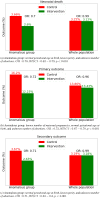Principled Subpopulation Analysis of the BetterBirth Study and the Impact of WHO's Safe Childbirth Checklist Intervention
- PMID: 37128422
- PMCID: PMC10148288
Principled Subpopulation Analysis of the BetterBirth Study and the Impact of WHO's Safe Childbirth Checklist Intervention
Abstract
The World Health Organization (WHO) developed the Safe Childbirth Checklist as an intervention to improve care and outcomes in maternal and newborn health. The original study reported that the intervention did not significantly improve the outcomes. In this work, we employ a principled data-driven analysis to identify subpopulations with divergent characteristics: 1) vulnerable subgroups with the highest risk of neonatal deaths and 2) subgroups in the intervention arm that benefited from the Checklist intervention with significantly reduced risks of deaths and complications. Results demonstrate that low birth weight represented the most vulnerable group, whereas mother-baby dyads described by normal gestational age at birth, known parity, and unknown number of abortions was found to benefit from the Checklist intervention (OR : 0.70, 95%CI : 0.62-0.79, p < 0.001). Generally, the flexibility of our approach helps to answer subgroup-based queries in the broader global health domain, which also provides further insights to domain experts.
©2022 AMIA - All rights reserved.
Conflict of interest statement
No conflicts of interest
Figures


Similar articles
-
Outcomes of a Coaching-Based WHO Safe Childbirth Checklist Program in India.N Engl J Med. 2017 Dec 14;377(24):2313-2324. doi: 10.1056/NEJMoa1701075. N Engl J Med. 2017. PMID: 29236628 Free PMC article. Clinical Trial.
-
Modification of oxytocin use through a coaching-based intervention based on the WHO Safe Childbirth Checklist in Uttar Pradesh, India: a secondary analysis of a cluster randomised controlled trial.BJOG. 2021 Nov;128(12):2013-2021. doi: 10.1111/1471-0528.16856. Epub 2021 Aug 25. BJOG. 2021. PMID: 34363293 Clinical Trial.
-
Unpacking the null: a post-hoc analysis of a cluster-randomised controlled trial of the WHO Safe Childbirth Checklist in Uttar Pradesh, India (BetterBirth).Lancet Glob Health. 2019 Aug;7(8):e1088-e1096. doi: 10.1016/S2214-109X(19)30261-X. Lancet Glob Health. 2019. PMID: 31303296 Free PMC article. Clinical Trial.
-
Induction of labour at 41 weeks or expectant management until 42 weeks: A systematic review and an individual participant data meta-analysis of randomised trials.PLoS Med. 2020 Dec 8;17(12):e1003436. doi: 10.1371/journal.pmed.1003436. eCollection 2020 Dec. PLoS Med. 2020. PMID: 33290410 Free PMC article.
-
Interventionist versus expectant care for severe pre-eclampsia between 24 and 34 weeks' gestation.Cochrane Database Syst Rev. 2018 Oct 5;10(10):CD003106. doi: 10.1002/14651858.CD003106.pub3. Cochrane Database Syst Rev. 2018. PMID: 30289565 Free PMC article.
Cited by
-
Sub-population identification of multimorbidity in sub-Saharan African populations.Sci Rep. 2025 Apr 22;15(1):13992. doi: 10.1038/s41598-025-96569-4. Sci Rep. 2025. PMID: 40263449 Free PMC article.
References
-
- Health TLG. Progressing the investment case in maternal and child health. 2021. - PubMed
-
- Hug L, Sharrow D, You D. Levels and trends in child mortality: report 2017. The World Bank. 2017.
Publication types
MeSH terms
LinkOut - more resources
Full Text Sources
Medical
